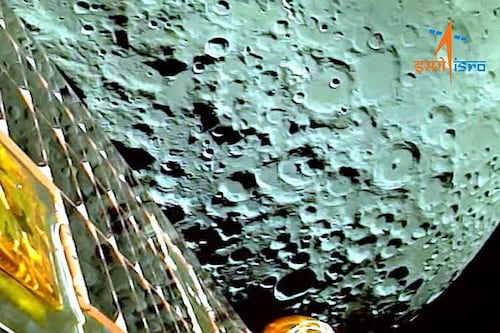A few things to know about Chandrayaan-3's moon landing
On August 23, Chandrayaan-3 is scheduled to land on the lunar south pole, a region still unexplored by humans


India is on the brink of making history with its third lunar expedition, Chandrayaan-3, poised to touch down on the lunar south pole at about 6 pm tomorrow. India and Russia had been in a race to reach the challenging south pole of the Moon, an area of great intrigue for scientists over the years. However, following the setback of Russia"s Luna-25 mission, India now seems poised to secure the distinction of being the first nation to successfully land on this uncharted territory, believed to harbour reserves of water ice.
Chandrayaan-3 was launched from Satish Dhawan Space Centre in Andhra Pradesh’s Sriharikota on July 14. Weeks later, on August 5, the lander entered lunar orbit. According to an update by Indian Space Research Organisation (Isro), it moved closer to the Moon on August 20, after the Lander Module (LM) completed its final de-boosting operation. Isro has consistently provided progress reports regarding the eagerly awaited landing. The agency recently unveiled images captured by the Vikram lander, showcasing the potential landing sites in advance of this momentous event. The latest photographs provide a glimpse of the Moon"s side that faces away from Earth, revealing distinct craters. As per Isro, these visuals were taken by a camera assisting the lander in pinpointing a secure landing site, free from boulders or deep crevices.
On the lunar surface, Chandrayaan-3 will conduct planned experiments for 14 days to collect more information about the lunar landscape, seismic measurements, and the availability of minerals. The elements to be studied include magnesium, aluminium, silicon, potassium, calcium, titanium and iron.
The lander will touch down on the lunar surface with a horizontal velocity of less than 0.5 m per second, a vertical velocity of less than 2 m per second, and a slope less than 120 degrees, as per a report by ABP News.
Upon the spacecraft"s touchdown, it will initiate the deployment of a rover named Pragyan, tasked with investigating the lunar terrain through chemical and visual examinations. The primary objective of the rover is to gather valuable information concerning the moon"s composition and geological characteristics.
The Vikram lander is scheduled to release four scientific payloads, aimed at analysing the temperature of the lunar surface and its subsurface attributes. As per a report by The Hindu, among these instruments is the ‘Spectro-polarimetry of Habitable Planet Earth’, designed to acquire information pertaining to the emission and reflection of light from Earth.
Chandrayaan-3 is set to engage in on-site scientific experiments aimed at investigating various aspects of the lunar environment, including its historical evolution, geological characteristics, and the potential presence of valuable resources.
The propulsion module of the lander will assume an orbital path around the Moon, dedicating its mission to the comprehensive study of Earth"s atmosphere from this unique vantage point. This endeavour involves a thorough examination of the Earth"s atmospheric conditions, its composition, dynamics, and interactions with outer space.
Chandrayaan-3 is strategically targeted towards the lunar south pole, a location recognised for its deposits of water ice. This resource holds the potential to serve as a critical reservoir for oxygen, fuel, and water, thereby offering invaluable support for upcoming lunar expeditions as well as the establishment of a sustainable and enduring lunar settlement in the future.
A successful soft landing on the Moon will make India the fourth country, after the US, Russia, and China, to achieve this difficult first step of interplanetary exploration.
First Published: Aug 22, 2023, 13:39
Subscribe Now